15358968703

Research on safe operation evaluation technology of blast furnace hearth
Abstract: Aiming at the problem that the current safe operation evaluation technology for blast furnace can not analyze the corrosion data of hearth lining, resulting in poor reliability of evaluation results, a new safe operation evaluation technology for blast furnace hearth is designed. Through the three parts of data collection and calculation of hearth lining corrosion, data processing of safe operation evaluation index and construction of safe operation evaluation model of blast furnace hearth, the design process of safe operation evaluation technology for blast furnace hearth is completed. Build the application test link, and analyze the use effect of this evaluation technology. According to the test and analysis, the application effect of this technology is better than the current technology, and it can be popularized.
Key words: service life of blast furnace; Operation status evaluation; Lining corrosion; Operation status monitoring; Fuzzy evaluation; Equipment health assessment
With the rapid development of productivity, the development of new energy and new technology and the expansion of product market, modern industry has gradually changed from the traditional integrated development to the flexible production mode. Whether it is the metallurgical industry or other product fields, each field has its core equipment, such as the generator in the vehicle, the engine or the blast furnace in the metallurgical industry. Its operation status is very important for the development of this industry, Once there is a problem in the operation of the equipment, it will cause economic damage and even endanger people's personal safety. The consequences will have a great impact on people's lives.
The service life of blast furnace is an important foundation for the industrialization of iron and steel manufacturing industry. In order to achieve the goal of high quality and low consumption in iron and steel production, the service life of blast furnace hearth should be extended as much as possible from the perspective of economy and safety. During the operation of the blast furnace, its hearth is the key part that affects its service life. When the abnormal state of the blast furnace hearth reaches a certain degree, the health of the blast furnace is also at risk. In this case, it is impossible to produce high-quality steel, which will also affect the output and the personal safety of the staff. How to carry out health management and real-time monitoring of blast furnace hearth in complex industrial process, and how to evaluate it with historical operation data, has become an important issue in the current industrial health maintenance management. Therefore, based on the current safe operation evaluation technology of iron making blast furnace, this study proposes a new safe operation evaluation technology of iron making blast furnace hearth, hoping to accurately evaluate the operation status of blast furnace through this technology, so as to improve the maintenance and management effect of blast furnace.
1. Design of safe operation evaluation technology for blast furnace hearth
The blast furnace ironmaking process is complex and needs to be coordinated. According to the blast furnace ironmaking process, a large number of equipment safety diagnosis and evaluation methods are analyzed before the design of safety operation evaluation. By monitoring the operation process of the blast furnace hearth, data collection and calculation of hearth lining corrosion, data processing of safety operation evaluation indicators The four processes of constructing the safe operation evaluation model of iron making blast furnace hearth complete the new safe operation evaluation technology of iron making blast furnace hearth, and set the design process of safe operation evaluation technology of iron making blast furnace hearth as follows, as shown in Figure 1.
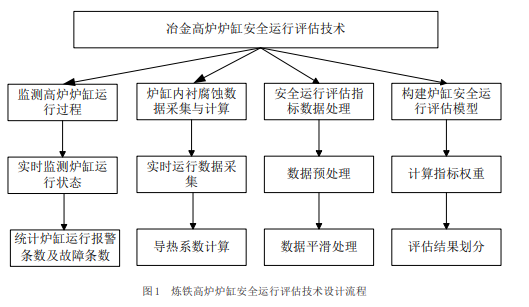
It can be seen from Figure 1 that this paper is based on the blast furnace structure and work flow and the hearth operation. According to the above design structure, appropriate methods and technologies are selected to optimize the current safety assessment technology and complete the research objectives.
1.1 monitor the operation process of blast furnace hearth
The operation of the blast furnace hearth is closely related to the electrical, instrument, weighing apparatus and operation settings. Now the external and internal conditions of the hearth in the PLC controller program are visually monitored to display the hearth operation picture and develop an independent tree view. When the hearth operation is abnormal, the blast furnace equipment operators and maintenance personnel can only click the relevant window to realize further operation, Timely handle the faults found during the operation of the hearth. When monitoring the operation status of the blast furnace hearth, analyze the relevant parameters of the hearth operation process, online diagnose the faults in the hearth operation, and the main monitoring of the blast furnace hearth includes the real-time recording of the operation process of the hearth top, trough, East and West slags, etc. in order to restrict the operation behavior, set the key operation log of the blast furnace, and record the operation behavior of the blast furnace operation and maintenance personnel on the blast furnace, It is beneficial to query the operation errors in case of hearth failure. Collect the data of important instruments, electrodes, scales and side skin current of the blast furnace hearth, record the time when the valves are switched in place, analyze and predict the impact of the detected data on the hearth operation trend through the storage and management of the above data, timely give an early warning when the hearth status is abnormal, and count the relevant fault information. The visual monitoring visually displays the hearth operation data, which is displayed in the screen in real time, and counts the number of hearth operation alarms and faults according to the daily spot inspection of the maintenance personnel, so as to facilitate the overall evaluation of the hearth operation.
1.2 data collection and calculation of hearth lining corrosion
Due to external interference, such as data damage and loss caused by the data acquisition device, in order to ensure that a large amount of original information is retained during data acquisition, this paper eliminates the abnormal data in the original sample set during data acquisition, and repairs the abnormal data through interpolation method. Due to the certain lag of the system time of the blast furnace hearth, As a result, the parameters in the data collection process also lag. Therefore, the blast furnace data has strict requirements on the time series of the data. The method of deleting abnormal values will cause the original data to be missing. Therefore, this method is not used. The values near the data are used to correct the abnormal values through the difference method. In this paper, the data of four times before and after the abnormal data are used for correction. This study will mainly calculate the corrosion data in the blast furnace hearth. Because the corrosion of the hearth lining is invisible, blast furnace workers often provide data basis for their operation evaluation by means of temperature monitoring, but this method can not determine the location of corrosion, which affects the reliability of the operation evaluation results.
1.3 data processing of safety operation evaluation index
Due to the complexity of the hearth operation and the immeasurability of the interior, the loading condition inside the hearth cannot be directly observed. It is necessary to judge the hearth condition through the observable parameter changes outside the hearth, in which the slag composition and material speed are important state parameters. According to the ironmaking principle, the state operation control parameters include air temperature, coal injection, etc. if the hearth condition is abnormal, Adjust and control the hearth to restore normal operation. In this paper, according to the main production process of blast furnace hearth ironmaking, taking the operation data of a hearth in an ironmaking plant as the main resources, the indexes such as furnace top pressure, average temperature and gas composition, average temperature at the edge of furnace throat, air supply volume and so on are selected as the evaluation indexes of hearth safe operation. The hearth lining corrosion is introduced into the safe operation evaluation index, and the data involved in the new evaluation index system are processed. Because some data need to be collected by sensors, the data is vulnerable to noise, resulting in abnormal data use results.
Therefore, the data will be smoothed in this study. In this study, according to the guidance of experts in related fields, 5-point 3-order processing is adopted to ensure the accuracy of data processing. Using the above calculation formula, it can make up for the peaks and valleys in the data and eliminate the noise in the data. After data processing, in order to ensure that the data is representative and the collected data is stable, it is necessary to test the stability of the data. Among them, the blast furnace hearth is stable and reliable when the operating parameters remain unchanged for a specific period of time. When analyzing the data, there will be spectrum leakage. Therefore, it is necessary to add a window to the data and add a window function to the data transmission signal, A suitable window function is selected to cut off the discontinuity at the cut-off point.
1.4 construction of safe operation evaluation model for blast furnace hearth
Use the processed data to get the characteristic vectors of each index, and calculate the index weight of each vector. In the safe operation evaluation of hearth, the index weight is only a part of the evaluation process. The importance of each functional module and part of the hearth is different, so a suitable algorithm must be selected to calculate the weight of each index. This research will mainly use the combination weighting method to obtain the index weight. On the basis of the existing analytic hierarchy process, a top-down hierarchical structure is established to analyze all the elements and connection relationships that lead to the failure of the hearth under the operating state, and the elements are classified and grouped to achieve hierarchical relationships. Too many elements in each layer will make it difficult to compare and judge. Therefore, the number of elements in each layer shall not exceed 7. After the hierarchical structure is completed, the judgment matrix is constructed, the relative importance of elements at the same level is given a certain measurement judgment, the importance relative to accuracy is obtained, and the scale is quantified. The 1-9 proportional scale method is commonly used to establish the judgment matrix, and the specific scale is shown in table 1.
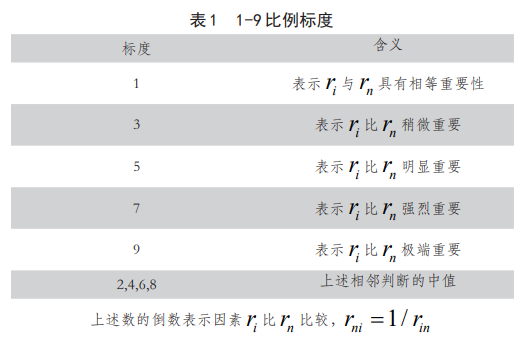
According to table 1, each element in the matrix can be judged. When the quantity of two different elements is extremely unequal in the comparison, the high-level elements are decomposed to ensure the consistency of the element orders. Based on the fuzzy comprehensive initial model, each object is given a yes value as the evaluation index, and the size of the comprehensive evaluation index reflects the overall evaluation level. Using the above formula, the assessment results can be measured more accurately, and the hearth can be maintained and managed according to the measurement results.
2. Application demonstration analysis
2.1 determining the weight of evaluation factors
The weight of each factor under safe operation can be evaluated by using the weight of each factor under operation status in the table below, as shown in Table 2.

Calculate the average value from the weight in Table 2 to obtain the weight of each factor. Secondly, determine the weight of each factor of the amount of sportiness change. According to the analytic hierarchy process used in this paper, the influence degree of each factor is scored by experts, and the weight value of each factor is obtained. According to the different influence degree of the change trend of each factor on the safe operation of the blast furnace hearth, the number after each factor is the scale of the factor.
2.2 sources of evaluation data
In this study, 2500 vertical blast furnace for iron making is selected as the research object, and the operation data and historical data of blast furnace hearth are collected on site as the data basis of this experiment. The specific collection results are shown in the table below.
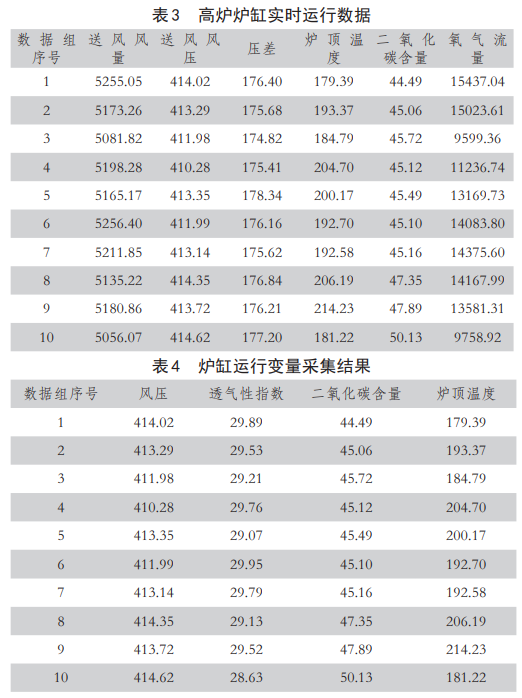
Using the above data as the data source in this experiment, the operation effect of blast furnace hearth is evaluated, and the application effect of the design method in this paper is analyzed.
2.3 experimental process
According to the operation status evaluation technology set above, the obtained data is substituted into it, and the data is normalized to obtain the data in the following table.
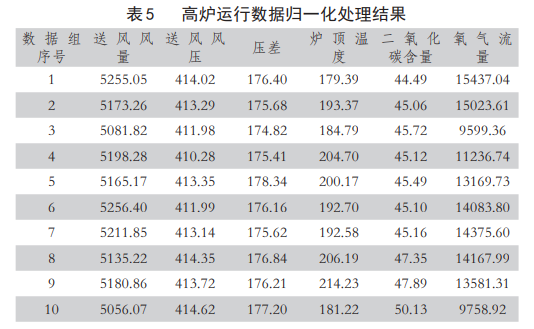
After obtaining this data, complete the data normalization according to the data processing requirements, extract the data features, and obtain the weight of each evaluation index according to the analytic hierarchy process to obtain the corresponding evaluation results. According to this principle, the historical data of blast furnace operation are processed, the corresponding evaluation model is constructed, and the final evaluation results of blast furnace operation are output. In order to better analyze the application effect of the evaluation technology proposed in this paper, two evaluation results currently in use are selected to compare with them, and the reliability of different evaluation methods for the classification of blast furnace operation evaluation grades is determined. In order to obtain the experimental results, the operation status of the blast furnace is divided into four grades, and 1 to 4 correspond to four parts: good, normal, fluctuating and abnormal. The performance of the evaluation technology is determined by comparing the data.
2.4 analysis of experimental results
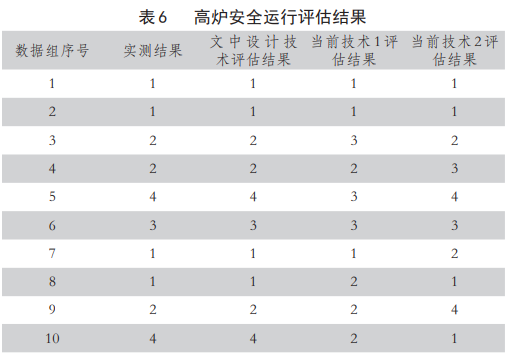
According to the above data, it can be seen that the results obtained by the design technology in this paper are basically consistent with the measured results, indicating that the results obtained by this technology are highly reliable, and the evaluation results are objective and accurate. When the blast furnace has problems, the maintenance can be completed in the shortest time to ensure the safe operation of the blast furnace. Grasp the operation state of blast furnace from the macro view, and provide scientific decision-making basis for its management and maintenance. In contrast, the two evaluation techniques currently in use show that there is a large difference between the evaluation results and the measured results, and the value of the results for reference is low, which can not provide powerful data for maintenance work. Based on the above, the experimental results show that the safety evaluation technology designed in this paper has good application effect.
3. Conclusion
By monitoring the operation process of the blast furnace hearth, collecting and calculating the corrosion data of the hearth lining, and processing the data of the safe operation evaluation index, this paper constructs the safe operation evaluation model of the blast furnace hearth for ironmaking, and puts forward a new type of blast furnace hearth operation evaluation technology. The application test shows that this technology is scientific and can be used in future research. Due to the limitation of time and conditions, this technology still has some problems that need to be improved and optimized. For example, many parameters involved in the blast furnace hearth need to be verified and supplemented in the actual operation. At the same time of parameter acquisition, it is necessary to strengthen the monitoring of the operation status of the blast furnace hearth to ensure that the acquired parameters are more accurate. This part will be completed in the future research to provide reasonable equipment evaluation and maintenance methods for the iron and steel industry.